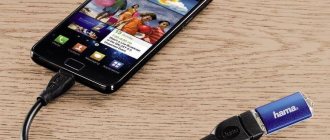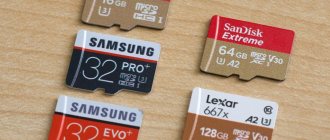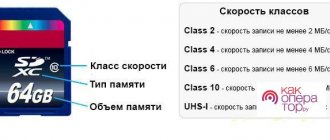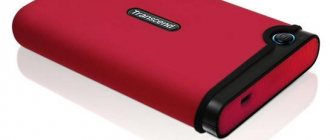Let's try to find out what class of memory card you should equip your smartphone, tablet, laptop, video camera or camera when such a need arises, and which class of memory card is better for each of these devices?
To do this, we will consider in detail what classification of memory cards currently exists, and how one miniature storage device differs from another.
Introduction
The requirements for storing information on a mobile device are growing every year. Games, photos, music, videos and other content require 3-5 times more space than 5 or 10 years ago. This is due to:
- Improved graphics and increased texture resolution in certain games.
- Increasing the camera resolution up to 40 MP and introducing 2-3 additional lenses.
- Availability of video recording in 4K resolution.
- A screen diagonal of 6 inches is considered the norm, which is why it is comfortable to watch movies in HD and FullHD resolution.
- Availability of DACs and/or audio codecs, which facilitates the transition to Lossless formats, for example Flac instead of MP3.
In addition, typical and highly specialized tasks require high throughput to perform: data input/output, 4K video recording, taking a series of images, etc. Therefore, in addition to capacity, appropriate write and read speeds are required.
Electronics manufacturers take into account changes in the market and make appropriate adjustments when updating their lineup. Thus, the amount of internal space in some flagship models reaches 256 and 512 GB, and the write and read speeds exceed 100 and 200 MB, respectively. However, the cost of such devices is unaffordable for many users. It is also much more difficult to restore information from a damaged device, as is the case with MicroSD and SD. Therefore, MicroSD and SD cards are the simplest, most affordable and fairly reliable option for storing information in electronic devices.
Purpose
First of all, it is important to determine for what purposes the memory card is purchased. Because for each operating mode it is better to select the appropriate type of drive. Typical use cases:
- Playing multimedia files.
- Taking photos and burst shooting 10-40 frames in a series.
- Record video in Full HD, 4K or 8K resolution.
- Installing applications and games.
- Shooting video in a car recorder or surveillance camera.
- Storing important information.
Conventional drives with an average throughput of 10-15 MB are suitable for most tasks. In particular, for shooting Full HD and 4K video with a bitrate of up to 60 Mbit, playing music and movies. Also for cameras with a resolution of 25 MP, serial shooting of 10-20 frames, single RAW images.
Multiple sequential RAW photos and multi-frame burst shooting require high-bandwidth storage up to 90 MB. And for SLR and DSLR cameras 110-240 MB.
High-quality video recording requires a card from the high-speed random data recording series.
If you plan to store games or applications on a memory card, it makes sense to use Application series cards. Such drives are characterized by increased data input/output speed while maintaining high performance.
It is better to use drives with regular cyclic recording for car recorders, external and internal cameras. Because such cards have increased recording resource.
To store important information and/or work in difficult conditions, it is rational to use drives that are resistant to temperature changes, moisture, X-ray and magnetic radiation.
Working with the tablet's internal memory
Moving process
The internal memory of many models is low, however, any user should know how to work with it: how to move data (files and folders) from the integrated memory to a memory card without using a desktop PC.
Attention: some icons in the screenshots may differ from your device, depending on the model and version of Android!
To move or copy a file from the internal memory, first make sure that a FAT32 formatted card is inserted into the tablet. Also make sure that there is enough free space on the card. Go to: Applications (Menu) => My files. Select the required file or folder. Press it and do not release it for 2-4 seconds. A check mark will appear. Press “Menu”; You will see a window with possible options.
Click on Move/Cut (specific arrow/scissors). When copying - “two sheets superimposed on one another.” Specify the “SD card” folder. Specify your destination, then confirm your action.
Moving stages
Form factor
Smartphones, tablets and a number of other electronics use the MicroSD format due to their compact dimensions. In some cameras, household players, etc. a different standard size is used - SD. Apart from the difference in size, MicroSD cards are compatible with electronics that use SD cards thanks to the appropriate adapter.
It is logical to consider purchasing a card with the most common size – MicroSD. If in the future you need to transfer the media to another device with an SD slot, you won’t have to buy a new card, just use an adapter.
SD card on the left, MicroSD card adapter in the center and MicroSD card on the right.
Which microSD memory card for a smartphone
If your smartphone supports microSDXC, it will also handle microSDHC memory cards and regular microSD. If, however, it only supports microSDHC, it may not recognize microSDXC cards. In other words, compatibility is maintained downwards, but not upwards.
In practice, the best and most cost-effective idea is to buy a 32GB or 64GB memory card. Most modern smartphone models support such capacities without problems, and we won't have to pay too much. Although a faster card with a larger capacity will cost significantly more.
Which microSD memory card is faster? Pay attention to the markings on the packaging and on the card itself.
Write and read speed
A key parameter that determines how quickly you can read or write information to a memory card. If the speed is insufficient, reading/writing data is accompanied by a noticeable delay, and during the writing process, artifacts or loss of some content may occur. Therefore, the speed of the drive must match or exceed the read/write capabilities of the device being used. For example, a smartphone records video at a speed of 4 MB per second, in which case you need a card with a similar speed or more - 6-10 MB. In this case, it is not advisable to consider options above 10 MB if a device that meets such requirements does not appear in the foreseeable future.
To choose the optimal drive, it is advisable to find out at what speed, whether a smartphone or a digital camera records data. This information is available:
- Directly from the electronics manufacturer.
- Screenshots of tests in reviews.
- In the properties of the photo and video file.
Based on the write speed, it is easier to select the required drive. Typically, manufacturers indicate speed indicators on the packaging, but more often the information is located directly on the memory card. Moreover, the read speed is rarely indicated, since this parameter is always higher than the write speed in all removable storage media.
Results
Now you know what parameters to look for when choosing a memory card for your tablet, and what is most important here. After all, it is not always the most expensive and newfangled copy that will work best on your device. Approach the selection process pragmatically and prudently, so as not to spend too much, but to buy the perfect one. Agree, studying the characteristics takes a few minutes. Which may subsequently save money, time, and even nerve cells.
Do you have your own secrets for choosing a flash drive for your tablet? Tell us about them in the comments.
Speed class
The standard displays the minimum sequential write speed of the drive, but actual values may be higher. At the same time, the speed of writing random data is often lower. It is designated as the letter “C” with a number, which means the write speed in MB/s: C2, C4, C6 and C10. Sometimes the recording speed is indicated as a multiplier - 32x, 48x, etc. The 1x multiplier is 150 KB/s, respectively, the 48x multiplier is 7.03 MB/s, which exceeds the C6 class.
Speed class marking for SD and MicroSD cards. The number indicates the minimum write speed MB/s.
Designation of the recording speed in the form of a multiplier.
What is the difference between micro SDHC and SDXC?
MicroSDHC and SDXC are the most popular memory card formats among users of computers and other gadgets.
MicroSDHC
This storage memory standard is the result of subsequent improvements to microSD. Flash drives of this format are similar in size, but have a much larger capacity (from 4 to 32 GB). In addition, their specificity lies in the higher speed of reading and writing information - from 50 to 150 MB/s.
It is worth noting that drives of this format are most often not identified by microSD readers. For our part, there are no difficulties with backward compatibility of flash drives and card readers. This is explained by the fact that microSD technology supports file systems such as FAT12 and FAT16 (in different versions), and drives are formatted in FAT 32.
MicroSDXC
The next technical threshold for improving SD technology is microSDXC drives. Their key advantage is their very large capacity, ranging from 32 GB to 2 TB. But the dimensions of the flash drive are similar to the previous drives, and are 11x15x1 mm. Devices of this format use the exFAT file system.
The speed of reading and writing information on drives of this format ranges from 50 to 312 MB/s. The exact meaning lies in the gadget version. Flash drives version 3.0, which are equipped with support for the UHS-1 standard, write and read information at a speed of 104 MB/s. Modification 4.0 gadgets that support UHS-2 technology can guarantee a value of 312 Mb/s.
Flash drive readers of this format can identify standards from previous generations. It is worth noting that card readers upgraded for microSD and SDHC do not support microSDXC format gadgets.
Similarities and differences
The difference between microSDHC and SDXC lies in such elements as:
- Flash drive capacity;
- Maximum speed of reading and writing information;
- File system used;
- Mutual compatibility of card readers that are adapted for certain types of flash drives.
It is worth noting that the dimensions of all flash drives are similar. The similarities and differences between drives are shown more clearly in the following table.
Similarities
| Similarities |
| Both types of drives are technical types made according to the SD standard |
| Card readers designed for microSDXC identify microSDHC flash drives |
| Drives have one purpose - to store information that is accessed through computers, phones, tablets and cameras. |
| Both types of flash drives have identical dimensions: 11x15x1 mm |
Differences
| MicroSDHC | MicroSDXC |
| Supports exclusively MicroSDHC and MicroSDXC readers | Supports exclusively MicroSDXC readers |
| Volume from 4 to 32 GB | Volume from 32 to 2 TB |
| Speed and reading class from 50 to 150 MB/s | Speed and reading class from 50 to 312 MB/s |
| Formatting to FAT 32 | Formatting to exFAT |
UHS bus
Ultra High Speed, or UHS for short, is a high-speed protocol for exchanging information, provided the card and device used are compatible. Marked with Roman numerals I, II and III, indicating the generation of the bus interface.
UHS-I data transfer speed reaches 104 MB. UHS-II cards have an additional set of pins, which allows for increased bandwidth up to 312 MB. The UHS-III standard will expand the transfer speed to 624 MB, but such cards have not yet gone on sale.
Cards with tire generation markings.
The best memory card for PSP
SanDisk Memory Stick PRO Duo
Memory card in Memory Stick Pro Duo format, compatible with many Sony devices in general and the PlayStation Portable portable game console in particular. Volume - 32 gigabytes, price - almost 300 rubles, which is not so expensive for a proprietary model. Adapter for Memory Stick included. This card is not compatible with most third-party devices, so do not try to install it in a camera or smartphone.
Price: ₽ 300
APC speed class
Application Performance Class, or APC for short, is an application performance standard. Marked with the letter A and a number indicating the version of the standard - A1 and A2. The minimum write speed is 10 MB, but key values are measured in IOPS - the number of data input and output operations. For A1, the minimum values for random read and write are 1500 and 500 IOPS, for A2 – 4000 and 2000 IOPS, respectively.
APC cards are designed to work in Android devices, with the goal of combining internal and external memory into one array, and then moving games and applications to the external partition. APC drives have higher IOPS compared to conventional drives, resulting in high performance when running games and applications.
Application performance class designation. It is measured in the number of data input and output operations.
Endurance class
Endurance or High Endurance is a conditional standard for drives with increased recording resource. Endurance memory cards are designed for regular video dubbing in home and outdoor surveillance cameras, car recorders and body cameras. Such drives do not have high write speeds, usually 10-30 MB, which is enough for shooting 4K video. On the other hand, the service life is 3-5 times higher compared to conventional flash drives.
Cards of the Endurance or High Endurance class are perfect for cyclic video recording in smartphones, video recording cameras or DVRs.
How to decrypt a memory card?
Go to the “Settings” -> “Lock screen and security” menu. Find the item “SD card encryption”. Disable it by selecting “Decrypt SD card” at the bottom.
Interesting materials:
How to bleach nylon curtains at home? How to bleach nylon curtains? How to bleach nylon curtains white nylon curtains? How to bleach a cashmere sweater? How to bleach yellow stains from sneakers? How to whiten sneakers with soda? How to bleach a cap? How to whiten a ceramic bath? How to bleach a robe with aspirin? How to bleach a robe with citric acid?
Additional protection options
Some cards additionally include up to four levels of protection for use in difficult and extreme conditions:
- Operating temperature from 25 to +85 °C.
- Water resistance. Resistant to moisture or maintains performance when in water for up to 72 hours.
- Protection against radiation. Preservation of performance after irradiation in X-ray machines up to 50 roentgens, for example at the airport.
- Magnetic field resistance. Equivalent to a powerful 15,000 Gauss MRI scanner.
Additional protection will help avoid card damage and/or data loss when exposed to: temperature, moisture, radiation and magnetic radiation. The exact quantity and quality of protection should be found in the description on the manufacturer's official website. Because the capabilities of different cards differ. If you cannot find information on the site, then you should contact the support service for advice.
Industrial class cards. Combine high reliability when used in difficult conditions.
Memory
The criterion determines the amount of information that will fit on the drive. Therefore, when choosing, you should proceed from your personal needs. Cards with nominal values of 2-512 GB are available for sale. The most popular cards are 16, 32, 64 and 128 GB.
At the same time, capacious drives contain several bonuses - less memory wear and higher data transfer speed. Because the efficiency of flash memory is affected by the occupied space. Therefore, the throughput of an empty 32GB card is higher than in a busy state. In this case, it makes sense to purchase a 64 GB drive. At half capacity, such a card will be faster and will last 2-2.5 times longer.
Estimated file capacity at a certain size. The number of photos received from the camera, the duration of video recording and the number of MP3 songs can change in both directions.
Compatibility
Often users are concerned about the performance of the selected card and compatibility with a particular device. It is worth highlighting three types of compatibility:
- Full . The device uses all the capabilities of the drive without restrictions.
- Partial . Only part of the storage capacity is used.
- Missing . The drive is not recognized and does not work.
Memory card standard.
For the selected drive to work, it is important that the device supports the same standard. There are three standards:
- SD , MicroSD – cards up to 2 GB.
- SDHC , MicroSDHC – drives with a capacity of 4-32 GB.
- SDXC , MicroSDXC – media with a capacity of 64-2000 GB.
The supported card capacity is indicated on the product page of the manufacturer's official website. To do this, you need to look at all the characteristics of the product. For example, the Motorola E5 smartphone supports MicroSD cards up to 128 GB. Therefore, any media within the specified volume is guaranteed to be recognized by the mobile device. But above the specified volume and support for additional technologies for high-speed data transfer, it is better to check with the support service of the electronics manufacturer.
The supported card capacity is always indicated on the device manufacturer's website.
If 32 GB is indicated on the product page, then cards with a nominal value of 64 GB and higher will not work, or a space of 32 GB will be recognized. In the case where the manufacturer specifies a class instead of the card size, cards of any size within the specified class are suitable.
Rating of high-quality microSDHC and SDXC memory cards
The speed with which the flash drive industry is being improved should be considered truly incredible, since not so long ago, with a capacity of half a gigabyte, a flash drive was a favorite acquisition. But today development is going so fast that now you can’t impress anyone with flash drives that exceed this value thousands of times in capacity, while maintaining the same dimensions.
But, at this point in time, manufacturers have not agreed on a universal standard. Despite this, it’s really worth noting the most popular types – microSD, SDHC and SDXC. And still, specific manufacturers are trying to promote their proprietary class by releasing gadgets with connectors for it. For example, the Sony brand and its unchanged Memory Stick.
By the way, even in the type itself there are a lot of differences, including price, capacity and speed capabilities. And here it makes sense to briefly recall the old days, when such a value as the reading speed reached only 1 Mb/s, and this was an incredible parameter. Well, today, when content is already made in 8K format, such a speed is a fiasco.
So, which type of memory card is better for a smartphone, and which flash drive is better to buy for a tablet? The rating of the best memory cards will help you sort out all these questions.
The best microSDHC memory cards
If a user needs to buy a storage device for a phone that is based on Android, then most likely it contains a microSD flash drive. The microSDHC category, for its part, is a “subtype” of micro SD flash drives. In terms of design, it is impossible to tell the difference between them. They have identical sizes, and devices that support microSD work similarly functionally with microSDHC cards.
The reason for creating microSDHC is clear: for some time before, during the formation of the microSD format, no one seriously thought that flash drives would exceed the capacity parameter above 2 GB. In this regard, the file system had a similar limit. “Hand in hand” with the formation of flash drives with a capacity greater than 2 GB, an innovative standard was formed. SDHC has what are called "classes". To put it simply, if the flash drive says “SDHC class 10”, this means that the reading speed is 10 MB/s.
Below is a top list of five flash drives of this format so that users can choose the one that suits them best.
"5th place: Transcend TS SDHC10"
This flash drive is not suitable for installation in DSLR cameras for professionals or 4K video cameras. Its limit is to be located in a practical chamber or to play the role of a backup storage device.
Since this flash drive does not support high speed, this played a significant role in its cost. There is no point for the user to worry about the durability of the memory card, because this drive will function well for many years.
It is worth noting that the media is used even in video cameras for amateurs that record images in FHD resolution. The fact is that the recording speed reaches 13 Mb/s, which is quite enough. Information is read at a speed of 20-21 Mb/sec, and this is quite a decent parameter.
Transcend TS SDHC10
Advantages:
- Availability;
- Popularity of models;
- Work stability.
Flaws:
- Speed capabilities are not very high.
The average price is 700 rubles.
"4th place: Kingston microSDHC Class 10 U3 UHS-I"
And this is a good solution for owners of innovative action cameras that can shoot video in 4K resolution. The speed capabilities here are such that there will be no problems even after 30 minutes of recording. If a person records videos extremely often and for a long time, then it would be logical to start looking for where it is profitable to buy such a drive with a capacity of 128 GB, regardless of the price.
Kingston microSDHC Class 10 U3 UHS-I
Advantages:
- The recording speed reaches 80 Mb/s;
- Reading speed reaches 90 Mb/s;
- There are flash drives with capacities of 16-128 GB on the market;
- An SD adapter is included in the package.
Flaws:
- Relatively high price.
The average price is 1,500 rubles.
"3rd place: SMARTBUY MICROSDHC CLASS 10"
A card for people who have decided to give up the characteristics of stable work at the expense of accessibility. This model will be a good purchase for a DVR, phone and tablet, rather than for specialized portable equipment due to the adapter included in the kit.
There is a wide range of capacity options on the market - 4-32 GB. In addition, the card is equipped with a standard speed of writing/reading information within 10 MB/s.
It is worth noting that the brand’s limited focus on microSDHC is explained by one understandable factor: the integrity of the information during multiple rewrite cycles is not ensured. And if for ordinary users the loss of information does not always lead to serious difficulties, then for photographers, for example, the loss of photographs from a shoot promises a serious blow to their reputation.
Advantages:
- Availability;
- Good quality;
- The package includes a network adapter;
- Work stability.
Flaws:
- Poor performance.
The average price is 500 rubles.
"2nd place: SanDisk Ultra microSDHC Class 10 UHS-I"
The displays of innovative phones most often have FHD resolution. And the incredible popularity of high-quality content plays a significant role in this. In this situation, if the user is a fan of watching videos, or his activities or hobbies involve regularly transferring data to a PC and back, this memory card will be an excellent purchase.
SanDisk Ultra microSDHC Class 10 UHS-I
Advantages:
- The card capacity reaches 32 GB. This volume is enough to save ten hours of video with a resolution of 1920 px;
- The drive has speed class 10, which means it is capable of exchanging information at a speed of 48 MB/s;
- The package includes a specialized adapter for a full-size SD connector, which is needed when working with a PC or photographic electronics.
Flaws:
- Rapid wear.
The average price is 500 rubles.
"1st place: SanDisk Extreme SDHC UHS Class 3 60MB/s"
Definitely the leader of this top. For a relatively budget price, the device guarantees breathtaking speed. Information is read here at 60 MB/s speed.
Reviews about the model prove that the US brand managed to release a high-quality device, because it “sucks” all the power out of SDHC. This drive is installed in cameras, video cameras, set-top boxes and other appropriate electronics.
The manufacturer claims that information is written to its flash drive at a speed of 40 MB/s, but owners say that most cards demonstrate even higher speeds, in some cases it reaches 54 MB/s.
SanDisk Extreme SDHC UHS Class 3 60MB/s
Advantages:
- There are modifications for 16 and 32 GB;
- High speed characteristics;
- Users experience virtually no glitches;
- Availability.
Flaws:
- Not detected.
The average price is 4,000 rubles.
The best MicroSDXC memory cards
Now even inexpensive phones record video with a resolution of 1080x1920 px. “Advanced workers” are capable of making videos in 4K format. Simply put, flagships shoot video with a frame width of more than 4,000 pixels. It is convenient to process such a video later due to the excellent clarity of the image, but it is completely uncomfortable to store. The fact is that only after a couple of minutes the user’s phone is able to shoot a video with a capacity of 3 to 4 GB.
Here the next difficulty arises - to record such a video, you need a flash drive with high-speed characteristics. Otherwise, you simply won’t be able to capture life’s unique moments. Media of this brand are made to overcome these difficulties that the SDHC format can no longer cope with:
- An improved file system, which made it possible to make drives with a capacity of up to 2 TB;
- Speed capabilities reach up to 300 Mb/s, and make it possible to record/open videos in high resolution.
If the user is going to constantly use the phone’s storage, work with videos and high-resolution pictures, then a card of this type is a good purchase. The selection criteria are easy to identify if you study the following top of the best memory cards of this format.
"5th place: Transcend TS SDXC10U1"
This flash drive easily stands out from its competitors thanks to its blue shell and colorful label. The manufacturer provides a flash drive with a capacity of 128 GB, which is quite enough. In terms of speed capabilities, the model is perfect for owners of video cameras that can shoot in 4K resolution.
Reviews about the model prove that owners of full-frame mirror-type cameras cannot do without a more expensive flash drive.
The bottom line is that flash drives from this line can cause some difficulties during long-term shooting (we are talking specifically about SLR cameras). However, other users will, in any case, appreciate the availability of the product, as well as its durability.
Transcend TS SDXC10U1
Advantages:
- Optimal cost;
- Good quality;
- Durability;
- There are modifications for 64 and 128 GB;
- Recording speed is approximately 70 Mb/s.
Flaws:
- Difficulties in working with some DSLRs.
The average price is 1,800 rubles.
"4th place: SanDisk Extreme Pro microSDXC (SDSQXXG)"
The best innovative flash drive for a phone or tablet. Its support for A1 class is guaranteed, and the model's small-block recording speed is actually higher than average. In addition, the media is read without prior caching, which is easily proven by performing memory tests on a mobile device. The flash drive does an excellent job of recording high-definition videos, including 4K format.
The range in this series of the company is so extensive that it would be appropriate to say that it is the tenth class UHS-I Class 3 V30 A1 card that is being considered. Although, the U1 modification of this flash drive is also excellent, but its speed characteristics are slightly lower.
SanDisk Extreme Pro microSDXC (SDSQXXG)
Advantages:
- Incredible write/read speeds;
- Incredible durability;
- Stability of work;
- The manufacturer guarantees excellent support.
Flaws:
- Counterfeits are common;
- Not the most affordable price.
The average price is 2,800 rubles.
"3rd place: Kingston SDA10"
This series includes flash drives in both SDHC and SDXC formats. It is worth noting that the former are most in demand because they are cheaper. SDXC cards meet the stated standards, and some models can write information at maximum speeds of 40 to 45 MB/s.
More capacitive models will delight you with a lower maximum speed – ranging from 30 to 35 Mb/s. Of course, the actual response is significantly less, but it is quite sufficient for video cameras that record images in FHD resolution.
The reading speed ranges from 60-80 MB/s, it all depends on the capacity of the flash drive you buy. The brand has been manufacturing solid-state media for a long time, which is why there is no point in worrying that the flash drive will break in a couple of years. Interestingly, such media are sold at a low cost.
>Kingston SDA10
Advantages:
- Excellent speed parameters;
- Stability of work;
- Availability;
- Popularity of models.
Flaws:
- Some models still do not meet the approved speed limits.
The average price is 2,500 rubles.
"2nd place: SAMSUNG MICROSDXC EVO PLUS 80MB/S"
The Samsung brand has quite a solid experience in manufacturing gadgets for storing information. Among the company's products there are full-size hard drives and the most practical media. It is among the latter that the model under consideration should be included. The colorful, red-and-white flash drive boasts a leading capacity (128 GB), excellent speed characteristics, and an excellent “resilience reserve.”
SAMSUNG MICROSDXC EVO PLUS 80MB/S
Advantages:
- Fashionable appearance. Among the black and gray flash drives, the colorful red product from the brand looks very nice. In addition, this drive is difficult to lose because it stands out among the things in your wallet/bag, etc.;
- Good speed characteristics. Today, read/write speeds of 80-20 MB/s are more than enough;
- Supports UHS Class 1 standard;
- Work stability. In reviews, customers say that the drive meets the approved capabilities, copes well with long-term write cycles, and does not heat up or break.
Flaws:
- Fragile shell.
The average price is 6,500 rubles.
"1st place: ADATA Premier microSDXC Class 10 UHS-I U1+SD adapter"
The carriers of this brand stand out for their accessibility while maintaining impressive values. The model will be a good purchase in a situation where you need to get a really high-quality product with high speed characteristics for a nominal price. The drive supports the SDA 3.0 data exchange standard, so the flash drive functions quickly.
ADATA Premier microSDXC Class 10 UHS-I U1+SD adapter
Advantages:
- Supports the UHS-I standard, while complying with the direction of SDA 3.0;
- Reading speed reaches 50 Mb/s;
- Despite the fact that the media is classified as an innovative SDXC format, its cost is comparable to SDHC cards.
Flaws:
- The recording speed is relatively low (10 Mb/s).
The average price is 2,500 rubles.
Manufacturer
There are three dozen brands on the global market, not counting little-known Chinese brands. It is preferable to choose products from well-known manufacturers with many years of experience in the development and production of drives: Samsung, SanDisk, Transcend, Kingston, etc. Since such companies have proven themselves well, they fulfill warranty obligations, and the defect rate is lower than that of the “Chinese”.
If you are loyal to a certain brand, have used the products before and were satisfied, then consider the offer of a personally verified manufacturer. Also, nothing prevents you from experimenting and trying your luck in buying little-known Chinese companies. At the same time, there is a high probability of buying a low-quality product with a short service life. Therefore, it is worth asking about the manufacturer from reviews of product owners.
Place of purchase
In foreign online stores in the USA, Europe or China, memory is usually cheaper than in local points of sale. However, most manufacturers provide warranty service only in the country of purchase. Because of this, shipping in both directions often turns out to be more expensive than a new card from the same store. And when buying from a seller from the Middle Kingdom, fakes often come instead of the original. However, it is not difficult to buy an original at a good price, provided you have experience shopping in foreign stores.
Local stores, particularly well-known retail chains, usually sell original products with a 2, 5 or 10 year warranty. There is no need to wait 2-4 or more weeks for the memory to arrive in the mail. At the same time, the cost of memory is often more expensive than in China.
Which option to choose is up to you. Need memory now and/or with warranty - local store. Delivery times and/or warranty availability are not a priority for foreign online stores.
Where to buy a memory card
Many online stores currently offer to purchase a memory card inexpensively and with delivery.
Please note: cards with less capacity are the least profitable in terms of the cost of one gigabyte; If you compare the cost of 1 GB in a four-gigabyte card and in an 8-gigabyte card, you will be convinced that it is more profitable to buy 8 GB!
For some reason, many users sometimes completely ignore this nuance, but in reality it is extremely important! The difference in price is sometimes quite impressive (up to 25% - 75% loss of budget for the user)!
Below are web resources where you can order a memory card in Russia and Ukraine:
- https://vk.cc/3xlFjQ;
- https://vk.cc/3xlFpp;
- https://vk.cc/3xlFvC;
- https://vk.cc/3xlFBe;
- https://vk.cc/3xlFF4.











